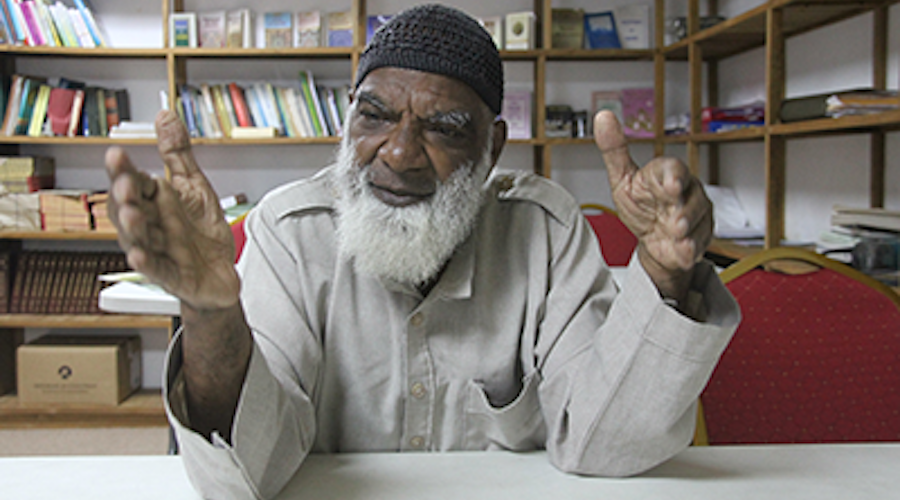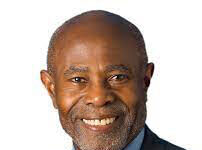By CIJN STAFF WRITERS AND CONTRIBUTORS
Trinidad and Tobago is a twin island republic known as the birthplace of steelpan and calypso. The oil-rich nation of Trinidad and Tobago is the western world’s highest per capita supplier of ISIS recruits. What would cause so many to leave this tropical paradise for a war zone?
RIO CLARO, Trinidad and Tobago, TUES. JAN. 7, 2020, CIJN: From a settlement in this small lumber town, Imam Nazim Mohammed operates a mosque, an elementary school and a weekly food program for the poor.
But Mohammed, 78, has earned a reputation that few in the West can match. Some 70 percent of the 130 Trinidadians who left the Caribbean nation to join ISIS in Syria and Iraq have lived on or near the 30 houses in the imam’s settlement. And among those who have left to join the jihadist group are some 15 members of his family.
The imam, who in 1990 joined Islamic militants in a bloody attempted coup, has been questioned by local authorities about the alarming number of people connected to him who have declared war on the West.
Mohammed insists that his loved ones did not inform him of their plans to join ISIS. He denies any personal connection to the terror group.
The issue of ISIS fighters from Trinidad have been chronicled by newspaper and magazine writers who expressed alarm that this tropical island, known as the birthplace of steel drums and calypso, could produce such a high number of radicalized killers.
A nine-month investigation by the Caribbean Investigative Journalism Network has for the first time revealed that:
- Many of the ISIS fighters from Trinidad belonged to a small Islamic networks of independent mosques that base their teachings mainly on Salafism
- For unknown reasons, local authorities have yet to arrest or charge anyone who sent recruits to the terror network
- The Trinidadians who travelled to Syria did so as families; there were no individuals
- One of the key cyber planners for ISIS was from Trinidad and Tobago
A strong body of research on radicalization suggests that social networks, particularly families, play a strong role in facilitating radicalization and recruitment to terrorist groups. Data collected by British criminologist, Dr. Simon Cottee, on Trinidadian ISIS travellers supports the claim that everyone in T&T who left for Syria and Iraq was part of the same network. They all knew each other, either because they were related or were friends. No one self-radicalized, and no one left for Syria and Iraq without the support of the network.
The network stretched across three main geographic areas: Rio Claro the south-east of Trinidad, Chaguanas in central and Diego Martin in the north-east. At center of the network, in the form of its leading spiritual authority, is 78 year-old Imam Nazim Mohammed, who remains in Trinidad and presides over his own religious settlement (a sizeable area of land that includes the mosque and around 30 houses he owns) in the rural town of Rio Claro. The majority of those who participated in the pro-ISIS network in Trinidad — nearly 70% — lived on or near Mohammed’s settlement before they mobilized for Syria/Iraq.
In media interviews, including one with the author, Mohammed has denied any association with ISIS, yet some 15 members of his family left to join the group in Syria and Iraq, including his daughter Aneesa, his son-in-law Daud Waheed and several of his grandchildren. Mohammed is also related to Emraan Ali, who married his grand-daughter and helped finance his mosque. In September 2018 the U.S. Department of the Treasury named and sanctioned Ali, along with fellow Trinidadian national Eddie Aleong, as a financier of ISIS. (Ali left for Syria, with his family, in March 2015; his current status is unknown.)
Mohammed’s network has its roots in the Jamaat al Muslimeen, a group of predominantly Afro-Trini Muslims led by Imam Yasin Abu Bakr. In July 1990 114 men from Bakr’s group, including Mohammed and one of his sons, attempted to overthrow the government of T&T, effectively holding the country to ransom for six days. They didn’t succeed, and Bakr and his men were tried for treason. After their release from prison (they were pardoned in 1992), Mohammed began to distance himself from the Al Muslimeen leader and eventually established his own religious community in the south of the country, where he embarked on a project of Islamic proselytization and disengaged altogether.
Raoul Pantin (who died in 2015) recounted his hostage experience and interaction with Imam Nazim during the coup in a book titled, “Days of Wrath – The 1990 Coup in Trinidad and Tobago.” Pantin wrote that Mohammed said what they were doing “was purifying a corrupt society as God’s work. As for taking up the gun, that too was God’s work. Our enemy has the gun.. we would be fools no tot take up the gun… we would be fools not to take up the gun. Allah has given man two hands to feed himself with. Whether we win or lose it is the will of Allah.”
Over the past three years in several media interviews, Mohammed denied running an Islamic State training program, and insisted that he operated an elementary school and a weekly food program for the poor. But he acknowledged that two of his children and five of his grandchildren were in Syria, and that the adults were believed to be involved with the Islamic State. In an interview with the New York Times in February 2017, he said, “Killing and murdering is not Islamic… Our program is to help people. You know how many people have come here for help?” He insisted that his children did not notify him of their plans, and he shrugged off the group’s influence. “Who is ISIS?” he said. “ISIS is just a few people.”
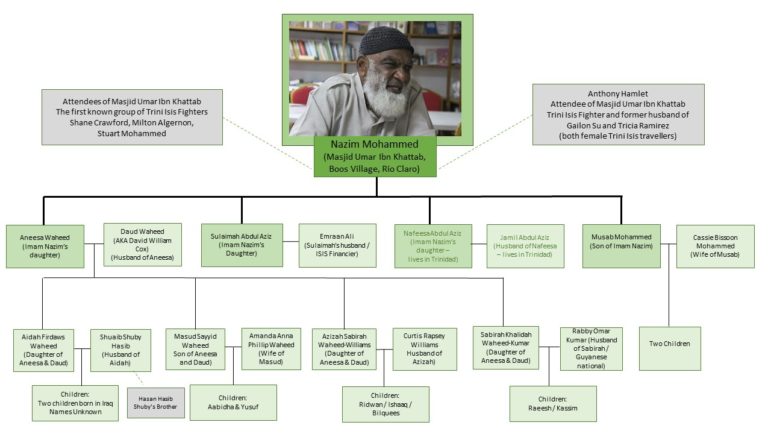
Chart showing members of Imam Nazim Mohammed’s family, most of whom travelled to Syria, and his links to other Trinidadian Isis migrants. This chart focuses on his children, grandchildren and great-grandchildren from his daughter Aneesa.
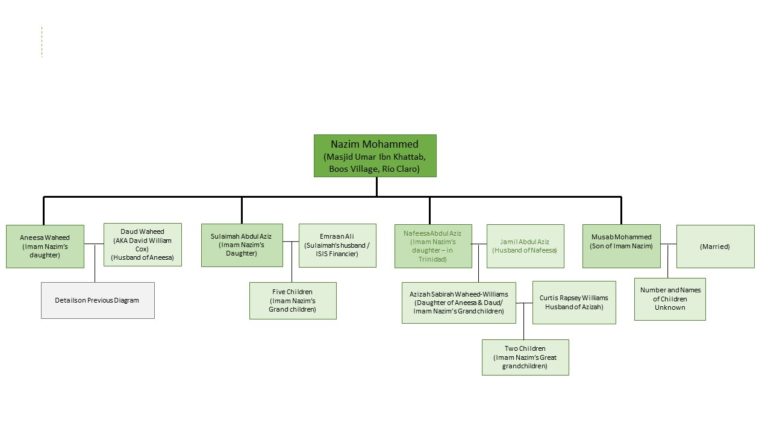
This chart shows other members of Imam Nazim Mohammed’s family, most of whom travelled to Syria, his other children, grandchildren and great-grandchildren.
The Foiled Carnival Terror Plot of 2018
In 2018 there was a Carnival terror plot which was foiled due to intelligence collaboration between the US Embassy and the Ministry of National Security in Trinidad. A total of fifteen people were arrested and questioned, a few homes and mosques were searched and only two people were charged for possession of a firearm. Trinidad may consider itself lucky to have escaped bombings or other planned attacks which were trending in the news at that time. But have those suspects been monitored? What about their associates?
One of the people questioned was Eddie Aleong of Enterprise in Central Trinidad. He was one of two Trinidadian men who were sanctioned by the US Treasury Department for suspicion of financing ISIS. His assets have been frozen but he has not been arrested nor charged. The question is how will the authorities in the twin island republic deal with individuals who are known to be liaisons for ISIS recruits?
Based on several credible reports, there are currently about one hundred T&T nationals at the Al Hol camp in northeast Syria. Although the majority are said to be children, there are women and possibly men. Is Trinidad and Tobago prepared for returnee ISIS families?
This mobile video circulated on social media in early 2019. It features the distinct voices of two female nationals of Trinidad and Tobago recorded at a camp in Baghouz. Viral social media video featuring the voices of two female nationals of Trinidad and Tobago
In 2018, the government of Trinidad and Tobago stated that 130 citizens had joined ISIS. However, sources linked the Ministry of National Security said that the number is closer to 240 people. The reason for the disparity is due to the fact that as time progressed, security intelligence got confirmation of who joined the “caliphate.” It is obvious that a lack of proper surveillance allowed Trinidadian IS migrants to go unnoticed. With a population of 1.3 million and approximately eight percent Muslim, the recruitment statistics are alarmingly high.
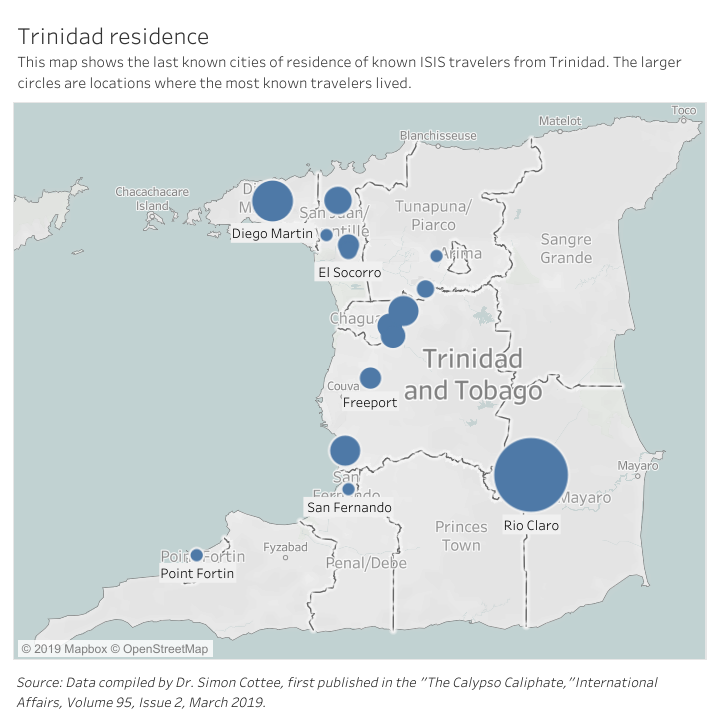
With the withdrawal of US troops, several detention camps and prisons have been compromised and refugee camps in places such as Al Hol are becoming overcrowded. The real numbers and life stories of ISIS migrants and their intentions are being uncovered. What factors led to their belief in being part of a movement wrought with violence and grounded in an ideology of Salafism?
Audio Clip from Muhammad Fraser, Expert on Countering Violent Extremism (CVE) issues
Known Stats on Trinidadian ISIS Migrants
(Based on Data of 70 known individuals.)
- Trinidad and Tobago is the highest per capita in the Western world for number of ISIS migrants
- 34% Male….. 23% Female…..43% Minors
- Trinidad & Tobago tops the list in the Western world for the number of female ISIS migrants and the number of migrant families
- All attended Salafi mosques Salafi: a far right branch of Sunni Islam which became popular in the late 19th century)
- ISIS migrants came from these mosques: Umar Ibn Khattab; Masjid Al Khaleefa; Masjid Da’Watil Haqq; Nur E Islam
- Of the known ISIS migrants it is estimated that approximately 70% came from Umar Ibn Khattab
Were they pushed or did they jump?
In May 2015 a family of 12 from Luton, England— including, according to the BBC, “a baby and two grandparents” – had made the journey to Syria. In a letter explaining their decision to go, they said: “None of us were forced against our will.” Indeed, in joining the caliphate they were now “free from the corruption and oppression of man-made law…in which a Muslim doesn’t feel oppression when practicing their religion. In which a parent doesn’t feel the worry of losing their child to the immorality of society. In which the sick and elderly do not wait in agony, tolerating the partiality of race or social class.”
Many Trinidadians who went to Syria and Iraq expressed the same thoughts and sentiments in their social media postings both prior to and after leaving Trinidad: that they wanted to live in an Islamic state where Islamic justice reigns and God’s rule truly rules. At the same time, they also expressed a profound spiritual disillusionment with Trinidad, which they saw as sexually permissive, corrupt, and lacking in any real value. Nowhere is this sentiment more graphically illustrated than by 34-year-old Ziyad Mohammed, who left for Syria in August 2014, just as ISIS started publicly beheading western hostages. Mohammed, who has now surfaced in one of the Kurdish-run prisons in northern Syria, recently stated: “Syria is better than Trinidad because it does not have such obscene acts as homosexuality and alcohol.”
The standard discourse on radicalization would classify this sort of sentiment as a “push”. But if the Trinidadians who joined ISIS were “pushed” it was not by anything or anyone in Trinidad that was doing the pushing, but by their own conviction that Trinidad was morally corrupt and had nothing to offer them. If they were pushed, it was because they wanted to be pushed and perhaps it is more accurate to say that they jumped. As one Trinidadian ISIS fighter (Ishmael Alexander, AKA Abu Saiftrinidadi) put it in a Facebook post, imploring his fellow Trinidadians at home to join him in Syria, “I had a nice house, car nice job work in oil love fishing an sports like any other young person Allah he test u wit this dunya [life] so wats the matter wit u wats ur excuse for not leaving darul kuff [“land of disbelief] an adhering to the Call of jihad fighting for Allah an[d] victory of Islam.”

Social Media Post by Ishmael Alexander AKAK Abu Saiftrinidadi, 9th June 2015
The Case of Tariq Abdul Haqq
A brilliant young man who at the age of seventeen was featured in T&T’s newspaper, Newsday (August 2007), as “The Schoolboy Gladiator,” describing him as disciplined and well-balanced.” Haqq was an aspiring lawyer who sought to follow in the footsteps of his well-known aunt and attorney at law, Pamela Elder. Before he left Trinidad he graduated from the University of London and represented Trinidad and Tobago in the 2010 the Commonwealth Games in Deli, earning a silver medal in the men’s super-heavyweight division.
Haqq travelled to Syria in December 2014, along with his wife, Abbey Greene and his sister Aliya also joined him. Jürgen Todenhöfer, the first western journalist allowed to enter ISIS-controlled territory in Syria and Iraq and make it out alive. Recounted his interaction with Haqq: “We saw people from all over the world…. from Sweden, France, and the United States. There was a guy from the Caribbean. Very good looking. Very charming. Stylish, Ray-Ban glasses. And I said, ‘What are you doing here’? ‘What have you done before?’ He said, ‘I’m going to do whatever the caliph is asking’.
How does an academically gifted young man with a local celebrity career in sport go on to become a foot-soldier for one of the world’s most violent terrorist organizations?

The Trinidadian Cyberplanner: Untangling the Web of an ISIS Conspirator Stuart Mohamed – Abu Isa Al Amriki Revealed
Abu Isa al-Amriki was first thought to be an American, then Sudanese. A two-year investigation by Dr. Simon Cottee identifies him as a Trinidadian
Until he got taken out in an U.S. airstrike in April 2016, Abu Isa al-Amriki was one of the most prolific external attack planners in ISIS, actively coordinating terror plots in North America, Europe and Asia. He was killed in Syria on April 22, 2016, with his wife Shadi Jabar (AKA Umm Isa al-Amriki), a 21-year-old Australian woman. While the names of other western ISIS cyberplanners are known, the identity of Abu Isa al-Amriki (henceforth Amriki) has never been publicly revealed – until now. His name is Stuart Mohamed, formerly an IT manager from a wealthy East Indian family in Freeport, Trinidad.
In the press statement announcing Amriki’s death, the then Pentagon Press Secretary Peter Cook said that Amriki, who also used the nom de guerre Abu Sa’ad al-Sudani, was a Sudanese national. Based on a two-year investigation, I believe that this is mistaken, and that he was in fact one of the 240 Trinidadians who travelled to Syria between 2013 and 2016 to join ISIS.
Submit a Tip or Story
- Your Name*
- Email*
- Message*
Amriki, as The New York Times reporter Rukmini Callimachi has comprehensively documented, was in contact with dozens of ISIS supporters in the West and used his Telegram account to solicit money from them and to guide them in carrying out attacks in their home countries. (Telegram is an encrypted messaging service that remains popular among ISIS supporters.)
One of the men Amriki was in touch with was Aaron Travis Daniels, a twenty-year-old warehouse worker from Columbus, Ohio. Daniels, who was being watched by the FBI Joint Terrorism Task Force since September 2015, wired $250 to Amriki via an intermediary in January 2016. He had also told Amriki of his desire to travel to the caliphate in Syria. On July 6, 2018, Daniels was sentenced to 80 months in prison. Prior to hearing about Daniels, Cottee hadn’t paid much attention to Amriki. But in reading the Department of Justice’s press release on Daniels’s arrest, Cottee was struck by one detail in particular: Amriki had advised Daniels to travel to Libya via Trinidad. Daniels had relayed this to an undercover FBI agent, telling him that he planned to go to via Trinidad so “the kuffar [non-believers] don’t track me”. It was the destination that caught his interest.
By the close of 2015, when Daniels had first reached out to Amriki via Telegram, ISIS recruiters were urging would-be recruits either to stay put in their home countries and conduct attacks there or to make their way to other ISIS provinces, like Libya, that were easier to reach. How did Amriki know that Trinidad was such a soft touch for jihadi travellers? And who did Amriki know in Trinidad who could assist Daniels if he needed to stay on the island for a few days prior to commencing his travel to Libya?
Shane Crawford, one of the first Trinidadians to join ISIS and one of the few to make it onto the U.S. State Department’s list of “Global Terrorists”, had referred to a certain “Abu ‘Isa” in an interview in July 2016 in Dabiq, ISIS’s now defunct glossy propaganda magazine. Crawford described how he, Abu ‘Isa and another man named Abu ‘Abdillah had journeyed to Syria together in late 2013. He also admitted to carrying out a double murder with both men, just weeks before leaving Trinidad and he recounted it in his interview in the ISIS magazine publication Dabiq:
“The operation was carried out in the middle of the city in broad day light and was caught on camera. It wasn’t our plan for it to occur that way, but it happened according to Allah’s decree. Following the operation, Abu ‘Abdillah and Abu ‘Isa were arrested, and I went into hiding. We decided that we had to leave Trinidad nonetheless because nothing was going to stop our hijrah [migration], by Allah’s permission. Once more, Allah bestowed a tremendous favor on us as Abu ‘Isa was released pending investigation…and we left Trinidad one-by-one. I left first along with my wife, followed by Abu ‘Abdillah, and then Abu ‘Isa, and we met up in Venezuela.”
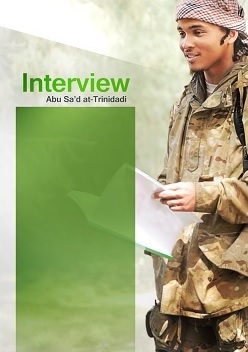
The “operation” that Crawford coldly alludes to here was the murder of two men – Joel Malchan, 29, and Dharmendra Sookdeo, 21 – at a busy interchange in Chaguanas, located in central Trinidad, on November 24, 2013. As their white Nissan station wagon came to a stop at a traffic light, they were startled to see a man approach them: This was Abu ‘Abdillah, whose real name is Milton Algernon (AKA Fareed Mustafa), a then 37-year-old sheep and goat farmer with a history of violence. He pulled out a gun and shot Malchan and Sookdeo twice in the chest, killing them instantly. Crawford and Abu ‘Isa, whose real name is Stuart Mohamed, were waiting for him and all three sped off in a car. Around ten minutes later the police intercepted the car, but not before Mohamed had dropped off Crawford and Algernon. Mohamed was arrested on suspicion of involvement in the killing and later charged for possession of a bullet that was found in his car.
On November 29, 2013, Mohamed was granted bail by a Senior Magistrate. He was also ordered to surrender his passport to the police, since state prosecutors deemed him to be a flight risk. But within days of being granted bail Mohamed had left Trinidad and was on his way to Syria with Crawford and Algernon.
One anonymous security source told Dr. Cottee that there is no record that Mohamed travelled with his passport and that he likely paid a counterfeiter to acquire a false one. According to Cottee’s source, “false passports are not hard to come by in Trinidad”. Several other anonymous security sources confirmed that Mohamed had travelled to Syria within weeks of the double murder in Chaguanas, including one of the officers who arrested Mohamed who said, “Our info was that he was killed in Syria.”
About a year after Mohamed had fled Trinidad his mugshot turned up on the Facebook page of T&T television crime show, “Beyond The Tape”.
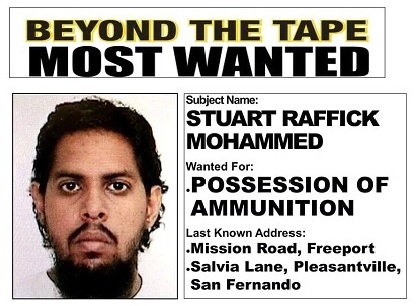
A day after the mugshot appeared Mohamed recirculated it on his Facebook page, sarcastically commenting: “they feel they could find me yeah right.” A month earlier, using the same Facebook account, Mohamed had sought to clear up the rumor that he had been killed in Syria: “As-salamu alaikum all my name is Stuart Mohamed I have been accused of some wrong doing but that doesn’t mean that I’m a bad person…I am well and alive.”

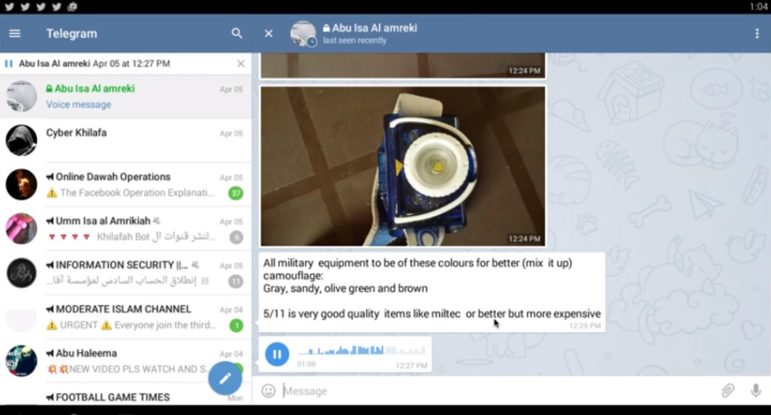
Image Courtesy: Freelance Journalists Jaspul Singh and Pritpal Singh
When Crawford, Algernon and Mohamed left Trinidad in late 2013 to travel to ISIS-held territory in Syria they were the first Trinidadians to do so, proving to their fellow Trinidadian jihadi wannabes that it could be done. Soon, hundreds of their fellow nationals followed in their footsteps to join ISIS in Syria and Iraq.
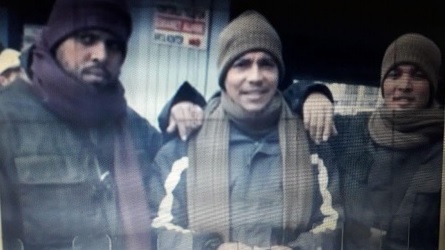
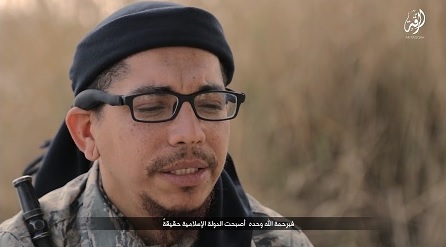
According to Crawford in the Dabiq interview both Algeron and Mohamed were killed in battle. Crawford himself reportedly died in February 2017, after succumbing to the injuries he sustained from a U.S. drone strike in October 2016.
All were prominent foreign members of ISIS, but Mohamed seems to have gone under the radar. He has never been identified in the local press in Trinidad as an ISIS member. Nor did he appear in any official ISIS propaganda, unlike Crawford and Algeron.
Cottee contacted Mohamed’s older brother and mother to see if they would talk to about Stuart, and confirm when he died. But they didn’t respond to emails. Two of Mohamed’s old hiking buddies said as far as they know Stuart had “done something very bad in Trinidad and gone to Syria and was killed there.”
After many months of probing, an associate of Mohamed’s was willing to speak about him. He said that Mohamed’s full kunya (nom de guerre) was Abu Isa al-Amriki and that he was killed in Syria, although he didn’t know when. He also confirmed Mohamed’s role in the double murder in Chaguanas, which, he said, was a revenge killing.
But why did Mohamed, a Trinidadian, use the kunya “al-Amriki”, which means “the American” in Arabic? The associate said that many Trinidadians who joined ISIS had some connection to the U.S. and that, in any case, it was common for them to use “al Amriki” on account of Trinidad being so close to South America. The associate also conjectured that the affiliation with America gave Trinidadians kudos among Arabs and Middle- Easterners who prized defectors from America and had never heard of Trinidad.
| Real Name | Nom de Guerre or ‘Kunya’ |
|---|---|
| Shane Crawford | Abu Sa’d at-Trinidadi |
| Milton Algernon | Abu ‘Abdillah |
| Stuart Mohamed | Abu ‘Isa |
| Anthony Hamlet | Faisal Farooq |
| Sean Parson | Abu Khalid al-Amriki |
| Chris Lewis | Abdul Rahim |
| Zaid Abdul Hamid | Abu Abdurahman al-Trinidadi, AKA Abu Zayd al-Muhajir |
| Aleem Alexander | Abu Mansour al-Muhajir |
| Ishmael Alexander | Abu Saif Trinidadi |
| Amalla Muhammad | Umm Saifullah |
| Aliya Abdul Haqq | Umm Muhammad |
| Tricia Ramirez | Umm Lioness |
| Aidah Waheed | Firdaws Waheed-Hasib |
And why “Abu Isa” and “Abu Sa’ad”? In Arabic “Abu” means “father of”, and in Islam it is common practice for jihadi fighters to use the name of their eldest son in their kunya. Facebook page has a photograph of his two sons, both of whom are in Trinidad. On October 30, 2014, when he would have been in Syria for ten months, he posted a photo of them: their names are Isa and Sa’ad. Dr. Cottee has never been able to establish why Mohamed used “Sudani” as a second geo-tag. But, as Rukmini Callimachi has observed, sometimes a jihadi’s geo-tag makes no sense at all.
Around the same time of this discovery, Cottee acquired a recording of Amriki from a British journalist, Jake Ryan. It was a two-minute voice-note that Amriki sent via his Telegram account. In it he encourages an undercover journalist to send money, computer equipment and cell-phones to an ISIS intermediary. Cottee played the recording to the Trinidadian criminologist and jihadist expert Daurius Figueira and he was categorical that the man speaking was an Indo-Trini (Trinidadian of East Indian descent), albeit one well versed in Quranic recitation. Two other sources – both police officers –were also adamant that the voice on the recording was that of an Indo-Trini.
According to Crawford’s Dabiq interview, Mohamed was killed in combat in a village near Azaz, “during the height of the Sahwah [uprising] in the Levant”. Crawford doesn’t put a date on his death, but Azaz is a city roughly 20 miles northwest of Aleppo in north-western Syria. Amriki, according to the Pentagon, was killed in Al-Bab, which is in the Aleppo province. Yet Crawford’s account makes it clear that Mohamed was killed in combat, while the Pentagon says that Amriki was killed in an airstrike by the anti-ISIS coalition. Both accounts must be treated with some degree of skepticism, given the propagandistic purposes to which they can be put by both sides. What is certain is that Mohamed was still alive as late as September 1, 2015, when he uploaded his last Facebook post.
“His family are millionaires,” according to one anonymous security source. “He’s a born Muslim… Stuart was always searching for something”, he said. That search led him to the radical cleric Nazim Mohammed and his mosque in Rio Claro. As the source described him, Mohamed was a true believer – and very radical: “He was opposed to the whole western system.” At some point – the source didn’t say when – Mohamed split from his first wife, who didn’t share his religious fervor, and moved away from the family home in Freeport and went to live closer to Nazim Mohammed in Rio Claro in south Trinidad. According to Dr. Cottee, his research on pro-ISIS activism in Trinidad indicates that nearly 70 percent of all those who travelled to Syria and Iraq passed through or lived on or near the Boos Settlement Muslim community in Rio Claro led by Nazim Mohammed.
- Average age of adult ISIS migrants is 34 years old which is a decade older than the average age of migrants in other countries
- Based on the seventy individuals on whom there is detailed data, the number of converts is 43%
- Based on social media feeds, there are still many pro-ISIS Trinidadians in Trinidad
- ISIS used the app, Telegram as a key communication tool
- At least 15 members of Imam Nazim Mohammed’s family left (he is the Imam at the Boos Village, Rio Claro mosque, Umar Ibn Khattab
Is Stuart Mohamed and Abu Isa al-Amriki one and the same person? The weight of the evidence points to this, although it is a claim that still needs to be confirmed by the authorities. What is beyond doubt is that Mohamed, who was facing criminal charges in Trinidad for his involvement in a capital offence, should never have been allowed to leave the country to join ISIS. Indeed, one of the most disturbing aspects of Mohamed’s case is the seeming ease with which wealthy and well-resourced ISIS supporters in Trinidad were able to evade the attentions of the security services and leave the country unhindered to engage in terrorist activities abroad.
Trinidad, which now faces a complex and severe returnee problem, with reportedly close to one hundred T&T nationals stranded in one detention camp alone in Syria, must now surely regret not putting up a more resilient opposition to so many of its nationals joining ISIS, especially given how high some of them rose in its ranks.

Part 3: The T&T Poster Boys of the Islamic State
While Stuart Mohamed went under the radar, some of his fellow Trinidadian jihadists occupied the limelight. Shane Crawford became an international poster boy for ISIS after his six-page feature in ISIS’s premier propaganda magazine, Dabiq. In this profile, Crawford explained he how came to Islam and embraced jihad. He also castigated his fellow Muslims back in Trinidad for remaining in “a place where you have no honor and are forced to live in humiliation, subjugated by the disbelievers”. More chillingly, he urged the very same Muslims to redeem themselves by murdering their fellow citizens: “Terrify the disbelievers in their own homes and make their streets run with their blood.” Video from Shane Crawford’s mobile phone in 2015 which was circulating on mobile and social networks and online media platforms.Episode 4 of podcast series, “Terror in the Caribbean”, Shane Crawford.
Curiously, Crawford never appeared in an ISIS video, but several of his fellow Trinidadian nationals did. One of them was a career extremist named Zaid Abdul Hamid, a thirty-nine-year-old from Chaguanas (Central Trinidad), not far from where Crawford grew up in Dass Trace, Enterprise (Central Trinidad). Hamid left Trinidad in April 2014, together with his wife and three boys, who were aged 7, 6 and 5 at the time. It’s likely that he knew Crawford well, since both men shared a jail cell together when they were arrested in 2011 on suspicion of plotting to assassinate then Prime Minister Kamla Persad-Bissessar and senior members of her cabinet – an offence for which they were not charged. According to an anonymous security source in Trinidad, Hamid was an associate of Abdullah el-Faisal, a Jamaican cleric who is currently facing charges in the U.S. for allegedly acting as a facilitator for ISIS.
It didn’t take Hamid long to make his mark in Syria. On August 2, 2014, ISIS released a video titled Eid Greetings from the Land of Khilafah. Filmed in Raqqa, it showcased the testimony of foreign fighters from all over the world. About halfway into the 20-minute video Hamid appears, holding one of his children. “I’m feeling like I’m still dreaming,” he says. “Please, all believers, come to Sham [Syria] as soon as possible. Do not make the shayṭān [devil] hold you back…look at all the little children, they are having fun.”
Hamid was captured by the Syrian Democratic Forces in late December 2018, a good few pounds lighter than when he appeared in the Eid Greetings video. In an interview with Fox News in January he was wholly unrepentant. He also claimed, in an interview with Vice’s Aris Roussinos, that he had not fought as a combatant in ISIS, but was only a medic. Yet the video evidence suggests otherwise: Hamid appeared in Flames of War 2, a hyper-violent official ISIS video released in November 2017. In one scene he can be seen carrying an automatic rifle in an active warzone, shouting: “We came here to take over this place and implement the sharia [Islamic law]. And after we take the neck off of Assad, we will take the neck off of Trump, inshallah [‘if God wills’].” (Revealingly, Roussinos told me that Hamid bummed two cigarettes from him, smoking one before the interview with him and another immediately after it, flagrantly transgressing ISIS’s prohibition against this practice.)
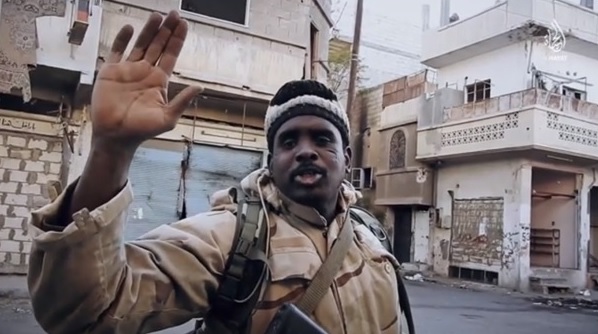
Even more prolific than Crawford and Hamid was Sean Parson (AKA Abu Khalid al-Amriki). According to a security source in Trinidad, Parson didn’t fight a single battle in Syria, but he was at the forefront of ISIS’s “cyber caliphate”, becoming a leading member of a Raqqa-based unit of English-speaking propagandists and attack planners dubbed “the Legion” by the FBI. Led by the British hacker Junaid Hussain (AKA Abu Hussain al-Britani), the group was terrifyingly effective, remotely guiding several ISIS plotters in the U.S. to carry out attacks there. In response, the U.S. killed all of its key members one by one in carefully targeted drone strikes.
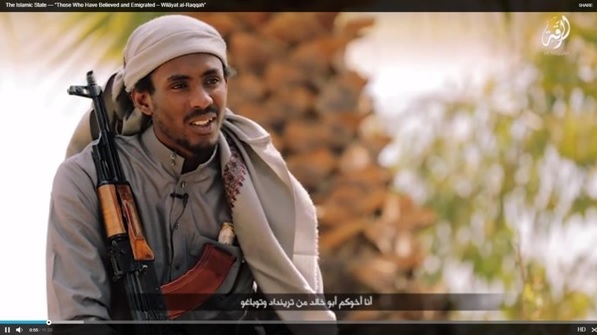
Parson was especially active on Twitter, using his numerous accounts to disseminate ISIS’s message and to directly communicate with supporters outside of Syria and Iraq. One person he was in close contact with was Keonna Thomas, a 32-year-old mother-of-two from Philadelphia. According to court records, Parson married Thomas over Skype and had encouraged her to join him in Syria. Ever the sweet-talker, Parson told Thomas, “U probably want to do Istishadee with me.” Istishadee refers to a suicide bombing. To this, Thomas gushingly replied: “That would be amazing…a girl can only wish.”
Thomas, who was arrested by the FBI the day before she was due to board a plane to Barcelona, from where she had planned to go to Turkey and onto to Syria, was also in communication with Abdullah el- Faisal, who may have introduced her to Parson.
In July 2015 Parson gave an interview to Australian journalist, Lauren Williams, who quizzed him about life in the caliphate. Asked whether he had participated in any beheadings, Parson answered: “Yes, a few days ago on the battlefield in Al-Hasakah [a city in Syria with a large Kurdish population]”. Two months after giving this interview, Parson was killed in a drone strike. In one of his last tweets he stated, perhaps in anticipation of his own fate, “You fly a remote control plane halfway across the world to kill an enemy that you are to coward to meet face to face.”
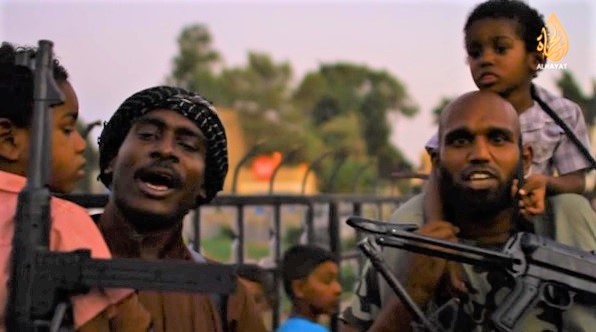
Captives and Returnees
Now, over six months after the fall of the territorial caliphate, the country faces the mother of all returnee problems: what to do about the scores of its nationals who are currently in detention in Syria and Iraq. This problem is all the more urgent given the uncertainty in northeastern Syria following President Trump’s decision to withdraw U.S. troops and support from the Syrian Democratic Forces (SDF).
In February 2019, Sky News interviewed a female detainee at the Kurdish-run Al-Hol camp in north-eastern Syria. Veiled and speaking with a Caribbean accent, she estimated that there were 90 Trinidadian children being held in Syria. “I would like to hear Trinidad’s view on the people who are here…Ninety kids. Do they care? Are they even concerned?”
It is difficult to know if this figure is accurate, since the Kurdish authorities in Syria do not share data on detainees with journalists or researchers. One local group in Trinidad, the “Concerned Muslims of T&T”, is calling for the repatriation of all Trinidadian women and children. According to them, there are 40 children and 16 women in the Al-Hol camp in north-eastern Syria alone. A story in Middle East Eye, dated 15th November 2019, claims that the number of Trinidadian children is as high as 70 in the Al Hol camp; of this number, 19 were reportedly born in Syria. The group is calling on the government of Trinidad and Tobago to bring home all the ISIS-affiliated Trinidadian women and children.
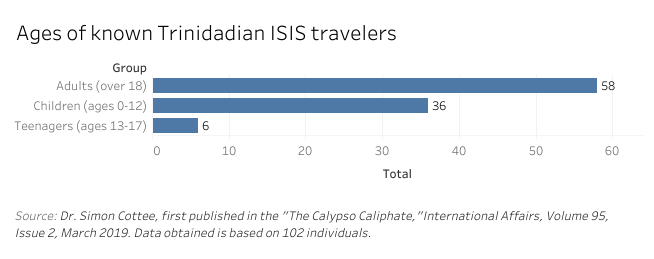
The moral case for the repatriation of Trinidadian minors is a strong one, since they are innocents who didn’t choose to go to Syria to join a genocidal religious-political movement. This makes them victims. ISIS was known for employing male children soldiers and for female children as brides. The emotional and mental condition of some of these children will require special attention and an effective social welfare system for them to be reintegrated to society. This infrastructure does not exist in Trinidad and Tobago and the government has not unveiled any plans on how they will deal with returnees.
There is another moral case, however, which is equally strong and flows directly from the one just stated: this is the case for prosecuting the Trinidadian women who took their children to Syria or Iraq. Under Anti-Terrorism legislation these women will walk free since at the time they left to travel to ISIS- controlled territory in Syria and Iraq it wasn’t a crime to do so in Trinidad, and ISIS had yet to be proscribed by the government as a terrorist group. (The revisions to the Anti-Terrorism Bill, which hinder travel to jihadi hot-spots abroad and clamp down on terrorist financing, did not pass into law until August 2018 and cannot be applied retroactively.)
There is also the issue of whether or not these women were complicit in committing war crimes or other human rights abuses, given that some ISIS women kept Yazidi slaves and reportedly fought on the battlefield. If women are allowed to return home how will the extent of their involvement be determined? Will they be able to live among normal citizens of Trinidad and Tobago and propagate radicalized ideologies or will they simply re-assimilate into society and Trinidadian culture and lifestyle? How will one be able to determine if female returnees were members of the Al-Khansaa Brigade (a female enforcement division of ISIS who not only fought on the front line but also punished other women who do not adhere to the rules of being an ISIS female).
Research Fellow at Lowy Institute, Lydia Khalil presented a paper entitled, “Beyond the Veil: Women in Jihad after the Caliphate,” and makes the point that the “Islamic State still views women as critical to the long-term survival of the organisation in their roles as wives, mothers, and indoctrinators of the next generation of jihad. In the words of one IS supporter smuggled out of Syria back to her home country: “We will bring up strong sons and daughters and tell them about the life in the caliphate. Even if we hadn’t been able to keep it, our children will one day get it back.”
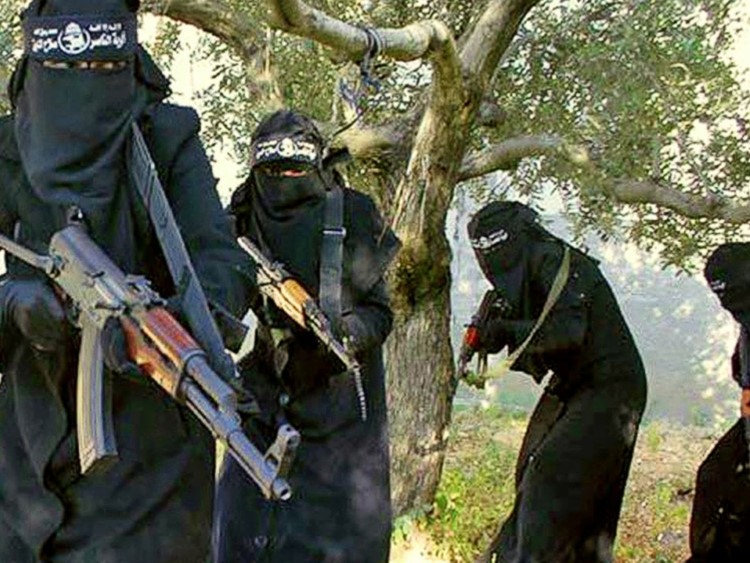
One possible way forward would be to prosecute the women under international human trafficking legislation, to which T&T is a signatory. The United Nations Protocol on human trafficking defines it as “the recruitment or receipt of persons…for the purpose of exploitation.” Under the Protocol, exploitation includes, “sexual exploitation, forced labour or services, slavery or practices similar to slavery…” In the case of child trafficking, only the act of recruitment and intent to exploit are relevant. It is a matter of record that ISIS was conscripting boys into combat as young as 10 and girls into marriages (and sexual servitude) as young as 9.
Imam Sheraz Ali (of Nur E Islam, El Socorro, Trinidad) has suggested that many ISIS-affiliated Trinidadian women were coerced or threatened into joining ISIS by their husbands. Ali has also remarked that there is no evidence that any Trinidadian women took part in the fighting in Syria and Iraq. While some Trinidadian women may have been coerced into going to Syria or Iraq, the account Ali presents is one-sided. Indeed, many, like Aneesa Waheed, Tricia Ramirez and Aliya Abdul Haqq, to name just a few, were die-hard supporters of ISIS who wanted to join the group; and, far from being “groomed” or “misled” into joining, they were, in fact, actively cheerleading for ISIS on social media before they left Trinidad. The idea they didn’t know what they were getting themselves seems contemptible.
The number of male Trinidadians currently in detention in these two countries remains unclear, although four men can definitely be accounted for: Zaid Abdul Hamid, Safraz Ali, and Nicholas Joseph Lee (AKA Abu Yousuf al-Amriki) and Ziyad Mohammed. The total number of Trinidadian male detainees is unknown. It is important to note that it is assumed that many fighters are dead but in some instances there has been no conclusive evidence. The recent case of Al Bara Shishani in Ukraine is a prime example. Shishani is Isis’ deputy minister of war and was thought to have been killed in battle. It was discovered that he used false passports to cross borders and is now in custody in Kiev. It is a dilemma faced by many countries and poor border control is an easy escape route.
Groups in Trinidad such as “Concerned Muslims” and individuals such as Umar Abdullah of the Islamic Front have been calling on government to ensure that T&T nationals are allowed to safely return home. Some members of the population are apprehensive about this, especially given the background of someone like Umar Abdullah who was investigated in 2002 to 2003 by American and British intelligence agencies for his possible links to Al Qaeda. According to reports in the local news at that time, newsletters published by the Islamic Front openly supported Osama Bin Laden, the Taliban and jihad and called for the setting up of an Islamic State in Trinidad and Tobago. Abdullah grew up in South Trinidad and once lived on Imam Nazim Mohammed’s settlement. Within recent times, Abdullah said he tried to dissuade some Trinidadian Isis recruits.
Some male nationals of Trinidad and Tobago in detention in Syria have sought to deny or minimize their involvement in ISIS. For example, 39-year-old Safraz Ali (Ali has two aliases: Ahmed Kanadi and Abu Henricki) claims that he didn’t know about ISIS’s beheading of western hostages before he left Trinidad and that he hadn’t fought on the battlefield for ISIS. Many other western ISIS-affiliated detainees have made similar pleas, insisting that they were misled into going to Syria and Iraq and that were only cooks or farm-hands for ISIS. These claims must be treated with a great deal of skepticism, and are clearly intended to garner sympathy.
Thus far there have been no public calls in Trinidad for the repatriation of male ISIS-affiliated Trinidadians. But the government should be prepared for their possible return and put mechanisms in place for this. Clearly, these individuals will pose a grave security risk, given their extensive combat experience. They may also, just like their female counterparts, try to sow further discord once they return. They must be rigorously assessed and closely monitored by the security services, and, where possible, tried for involvement in war crimes in Syria and for trafficking their children into ISIS.
Interim Chair of the Islamic Round Table in T&T, Mr. Hafeez Khan shared his view on the returnees, stating that his personal belief is that “those who went knew what they were getting into.”
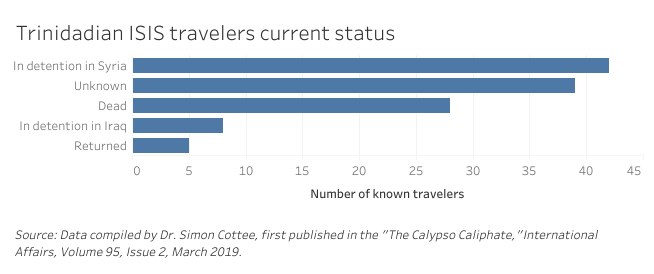
The government must also invest more resources into counter-terrorism. At present, counter-terrorism efforts are spearheaded by the SAA (Strategic Services Agency) and Special Branch, two branches of the state that do not always cooperate effectively and openly with each other. The Police Commissioner Gary Griffith has long called for a specialist unit devoted to monitoring and foiling terrorist threats. The case for introducing such a unit is now overwhelming.
In August 2018 the T&T government passed legislation to clamp down on terrorist funding and to stop people from going to terrorist hot-spots like Iraq and Syria. This, though late in coming, is to be commended. However, it has yet to fully address the issue of radicalization in the country. In America and Europe, governments have supported efforts to “counter-message” violent extremists and empower communities to protect themselves against the recruiters and radicals. Should the T&T government do the same?
The U.S. Embassy in Trinidad has engaged several community groups as part a CVE (Countering Violent Extremism) programme to develop sustainable engagement and empowerment social models with the goal of “counter-messaging” to address various forms of radicalization.
The T&T government needs to become involved in such projects while also proceeding with caution in who it enlists as community partners. Whatever it chooses to do on this front, its efforts should be carefully calibrated and focused exclusively on engaging those communities in which ISIS recruitment has been taking place and on the mosques – in Rio Claro, Chaguanas and Diego Martin – most closely associated with the block migrations to Syria and Iraq. For too long the government has slept on the problem of violent extremism. It is time for it to take a more proactive and positive approach.
On Sunday 17th November 2019, Minister of National Security, Stuart Young, said, “As Minister of National Security, I am ensuring that the relevant authorities are conducting verification and information gathering exercises and I will say that some of the evidence obtained so far with respect to some Trinidadians who went to join ISIS is very disturbing… at National Security, rest assured that we will continue to act responsibly and based on facts and evidence using, inter alia, Team Nightingale to ensure that the best decisions and actions are taken in the public interest.” Team Nightingale is comprised of several units of the Ministry of National Security and was formed to deal with the reintegration and repatriation of TT Nationals.
“Some of the evidence obtained so far with respect to some Trinidadians who went to join ISIS is very disturbing.”
Minister of National Security, Stuart Young
17th November 2019
On 25th November 2019, the Minister of National Security of Trinidad and Tobago, the Honourable Stuart Young, hosted a meeting with a team from the Embassy of the United States of America and discussed matters related to the repatriation and reintegration of returnees. A press release on the meeting stated that Minister Young “reiterated his commitment to advancing bilateral security cooperation to ensure the safety and security of all persons in Trinidad and Tobago.”
Our follow up stories will look at other Caribbean nations as well as the on-going issues in Trinidad and Tobago.

About CIJN Staff Writers and Contributors
The Caribbean Investigative Journalism Network is the region’s premier investigative journalism organisation producing engaging stories for multiple platforms.






